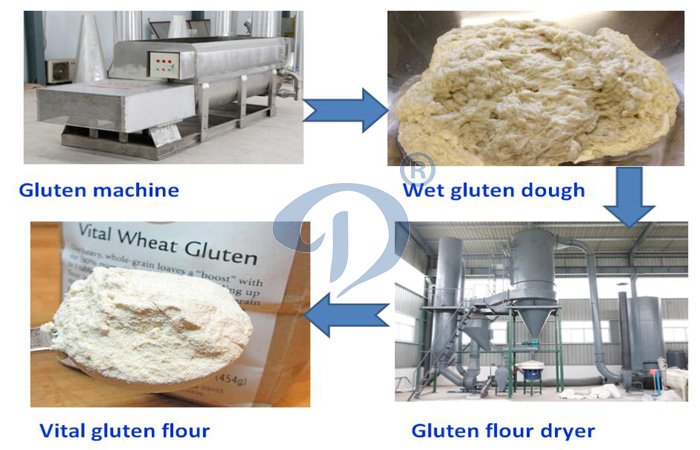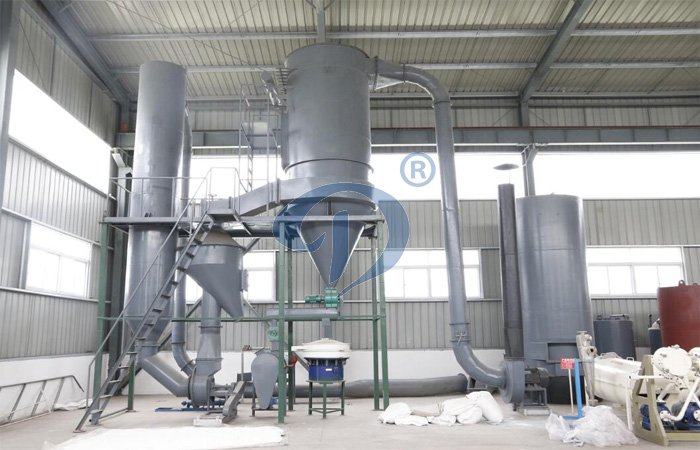What is wheat starch and gluten manufacturing process?

Wheat starch and gluten machinery
Process gechnologies of wheat starch and gluten manufacturing:
The technologies used for wheat starch and gluten separation have evolved from the early Martin Process. This was essentially a flow starting with a stiff continuous dough, not too unlike the continuous dough processes popular in the United States in the 1960s and 1970s.
The problem with this system was the large amount of process water used (more than 15 parts of water to one of flour), the length of time taken to complete the process, a tendency for the gluten to begin to devitalize through the working of the dough and the relatively small capacities of fewer than five tonnes per hour. Effluent was a big problem, creating treatment costs at the sewage plant, and energy costs were high.
A milestone breakthrough came in the late l970s with the patented Raisio Process. The essence of this process was the observation by the Finnish inventors that a centrifuged slurry of flour and water produced a layer: "A" starch first, gluten next, then "B" starch and lastly solubles.
While this characteristic was well known, the Finns used this knowledge for the first time in wet processing. They came up with the clear concept to separate the constituent parts in their natural sequence of specific gravity.
Other companies and workers have devised in-house systems that are not dissimilar, the objectives being to maximize yield and product purity while minimizing water usage and therefore energy.

starch_
Technologies of wheat starch and gluten manufacturing have advanced with the advent of various batter, rather than dough, methods. Capacities today reach well over 40 or 50 tonnes per hour of flour, using water to flour ratios of 2.5 to 1 or better. Also, processes now are self-contained in that material does not disappear down the drain, which helps prevent environmental problems.
The flow illustrated in block form in the diagram includes wheat flour milling as part of the starch/gluten manufacturing facility. This is not strictly necessary, but the objective of producing starch/gluten from wheat flour clearly is better served by a dedicated flour mill.
On the other hand, a flour mill under the total control of the wet processor means that extraction and particle size can be optimized. What is more, wheat supplies can be sampled and selected according to best advantage.
contact us
- Do you want to buy machine?
- Yes, I want to buy machine
- No, I want to learn more in advance.
- What is your raw material?
- Cassava
- Potato
- Sweet potato
- Others
- 2. What is the final product you want to produce?
- Garri
- Cassava flour
- Cassava starch
- Cassava chips
- Attiekie
- Bammy
- Others
- 3.What is your capacity plan?
- Small scale garri machine
- 1ton per day
- 2tons per day
- 3tons per day
- 10tons per day
- 20tons per day
- Others
- 3.What is your capacity plan?
- Small scale
- 5tons per day
- 10tons per day
- 20tons per day
- 50tons per day
- 100tons per day
- Others
- 3.What is your capacity plan?
- Small scale
- 5tons per day
- 10tons per day
- 20tons per day
- 50tons per day
- 100tons per day
- 200tons per day
- 300tons per day
- Others
- 3.What is your capacity plan?
- Small scale
- Middle type
- Large scale
- What is your capacity plan?
- Small scale
- 5tons per day
- 10tons per day
- 20tons per day
- 50tons per day
- 100tons per day
- 200tons per day
- 300tons per day
- Others

 Call us
Call us Chat online
Chat online

